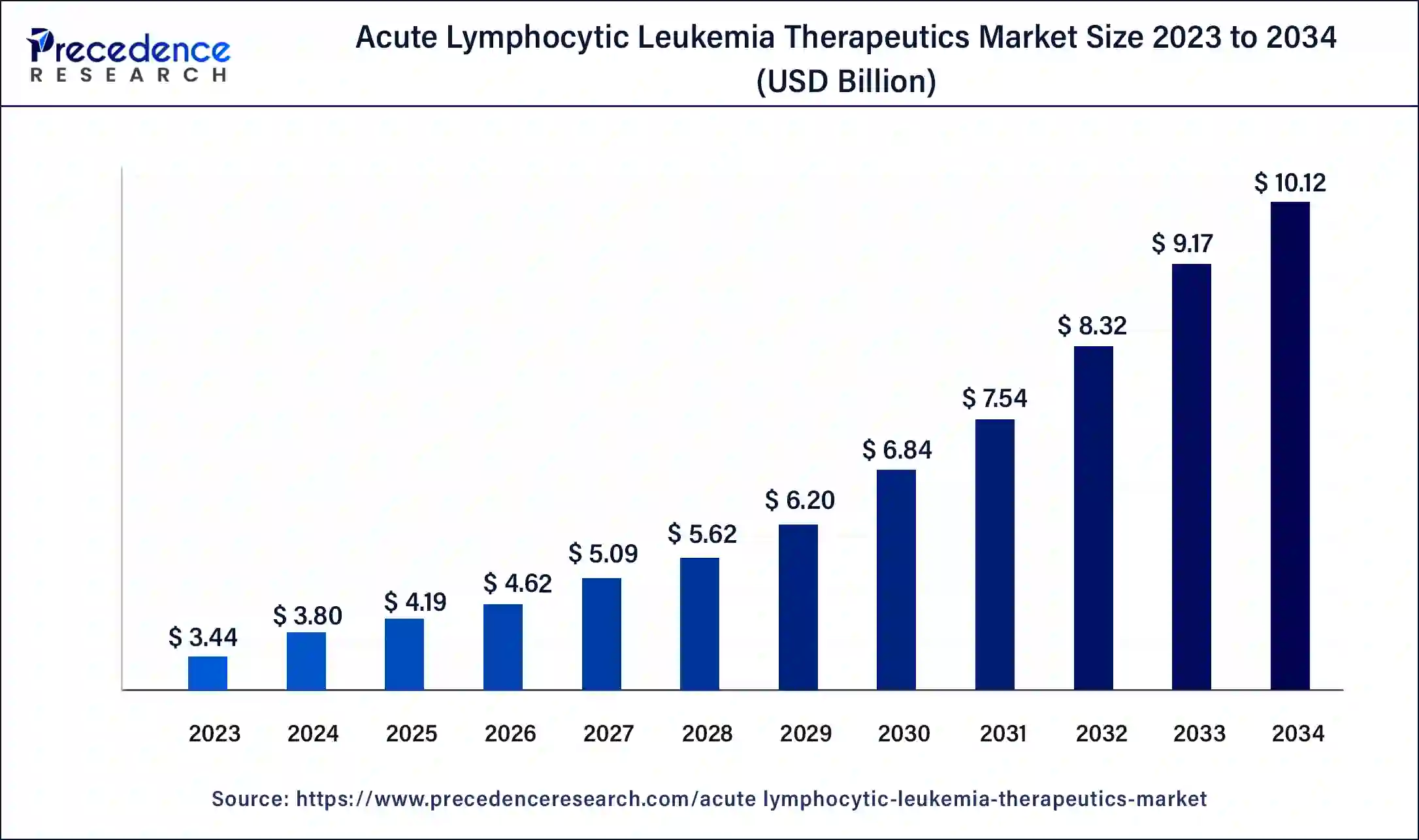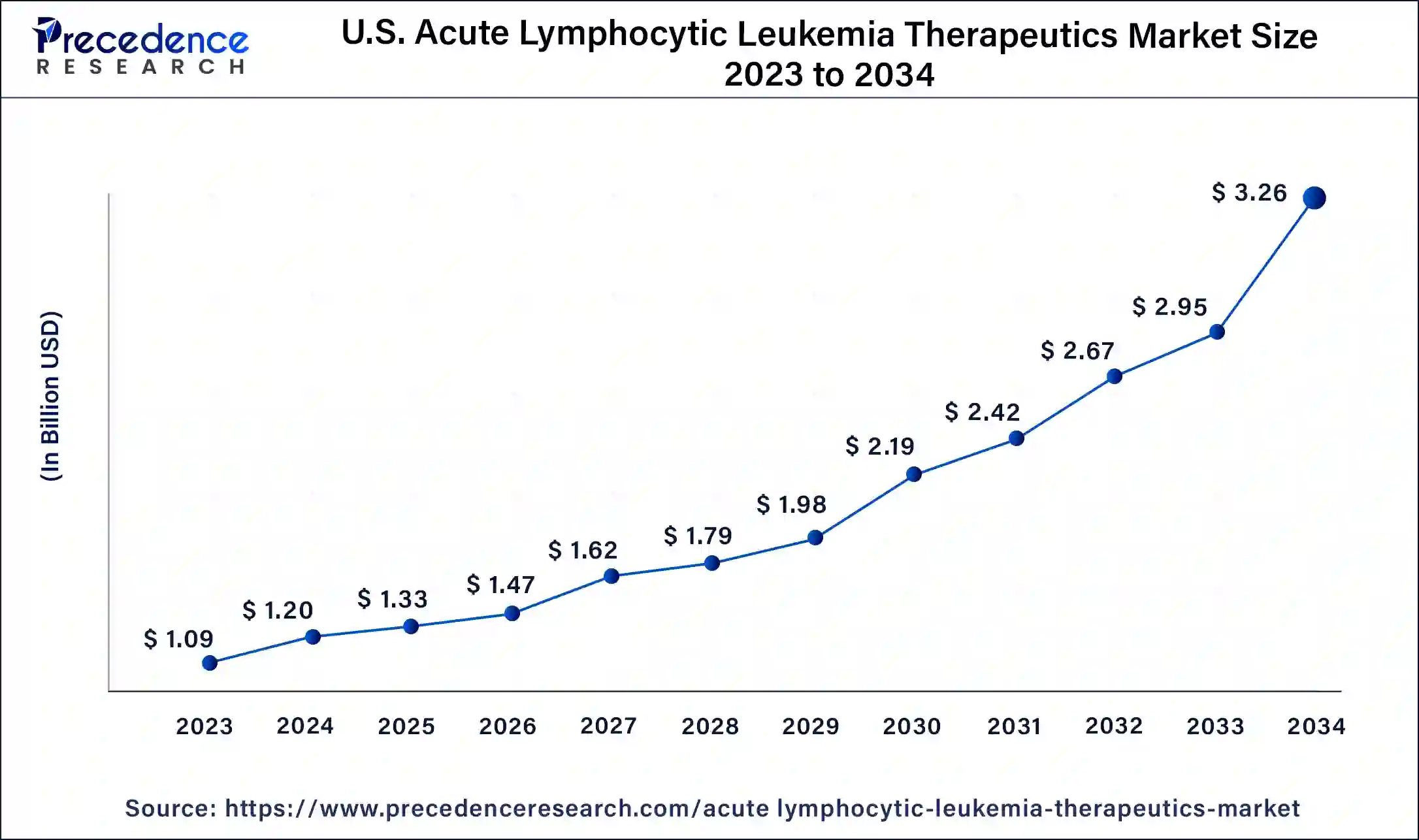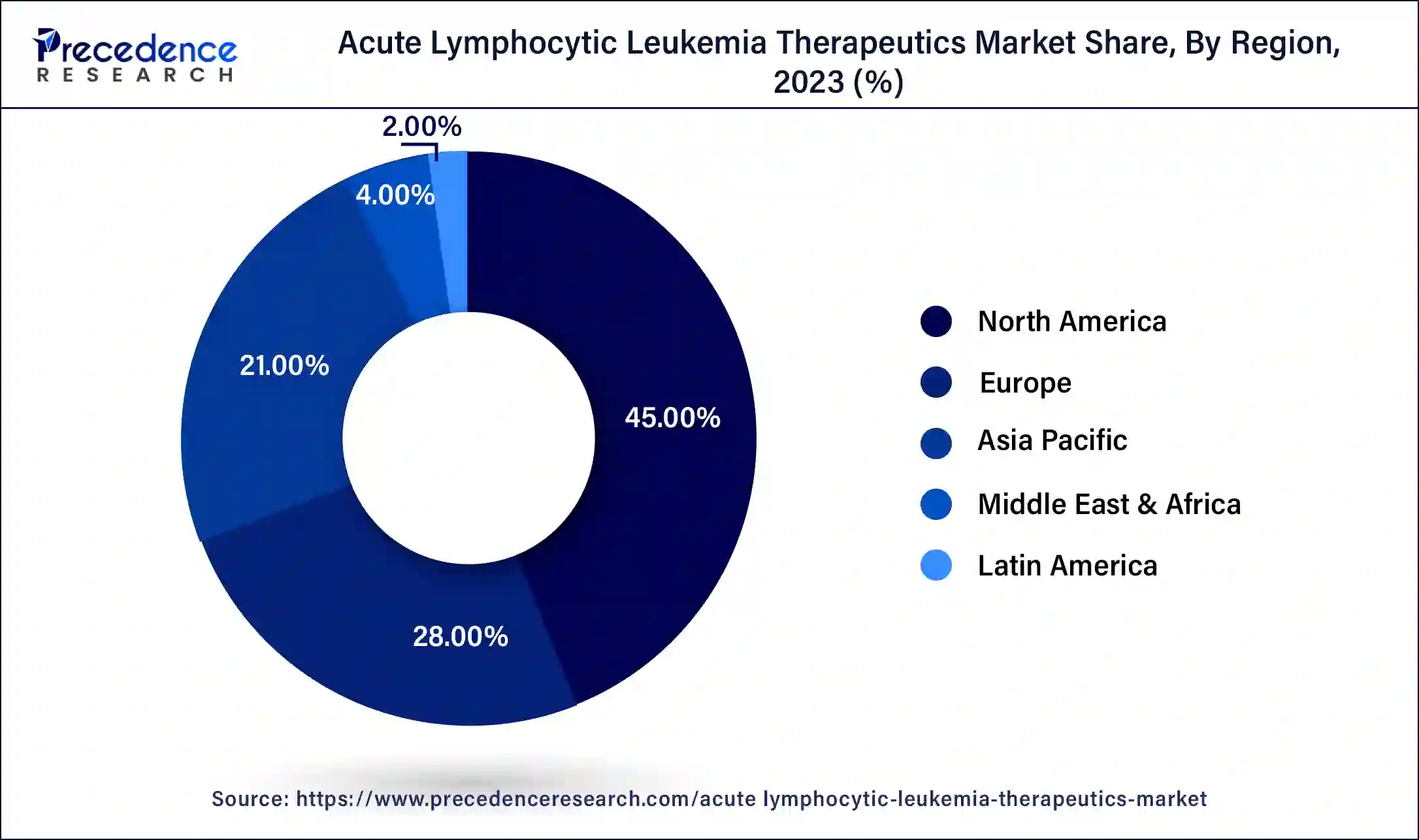January 2025
The global acute lymphocytic leukemia therapeutics market size was USD 3.44 billion in 2023, calculated at USD 3.80 billion in 2024 and is projected to surpass around USD 10.12 billion by 2034, expanding at a CAGR of 10.3% from 2024 to 2034.
The global acute lymphocytic leukemia therapeutics market size accounted for USD 3.80 billion in 2024 and is expected to be worth around USD 10.12 billion by 2034, at a CAGR of 10.3% from 2024 to 2034. The North America acute lymphocytic leukemia therapeutics market size reached USD 1.55 billion in 2023.

The U.S. acute lymphocytic leukemia therapeutics market size was estimated at USD 1.09 billion in 2023 and is predicted to be worth around USD 3.26 billion by 2034, at a CAGR of 10.5% from 2024 to 2034.

In 2023, North America dominated the market, accounting highest market share. Significant market players in the US and well-recognized healthcare infrastructure and technological advancement are the primary factors contributing to the country's considerable market considerable share.
Additionally, the US is expected to see substantial expansion owing to the drug reaction (inotuzumab ozogamicin) released in August 2021 and robust pipeline drugs such as eryaspase (asparaginase), which is in phase II clinical trials. Furthermore, expanding private healthcare institutions and high spending power in individuals are expected to drive market growth during the forecast period.

Acute lymphocytic leukemia is a type of blood and bone marrow cancer, and bone marrow is the spongy tissue inside bones that produces blood cells. The ongoing clinical trials for acute lymphocytic leukaemia therapeutics, such as consolidation therapy with Blinatumomab to establish survival rates in recently diagnosed adult patients with B-lineage acute lymphoblastic leukaemia in quantifiable residual disease negative remission, which ultimately resulted from the ECOG-ACRIN E1910 Randomized Phase III National Cooperative Clinical Trials Network Trial, are expected to provide ample opportunities in the future.
| Report Coverage | Details |
| Market Size in 2023 | USD 3.44 Billion |
| Market Size in 2024 | USD 3.80 Billion |
| Market Size by 2034 | USD 10.12 Billion |
| Growth Rate from 2024 to 2034 | CAGR of 10.3% |
| Largest Market | North America |
| Base Year | 2022 |
| Forecast Period | 2024 to 2034 |
| Segments Covered | By Type, By Drug, By Cell, By Therapy, By Route of Administration, and By Distribution Channels |
| Regions Covered | North America, Europe, Asia-Pacific, Latin America and Middle East & Africa |
Rise in incidence of the acute lymphocytic leukemia
The rise in the incidence of acute lymphocytic leukemia is driving the market’s growth. According to the American Cancer Society research, acute lymphocytic leukemia in the US for 2023 is about 6,540 new cases, of which 3,660 were male and 2,880 females. The mortality is about 1,390 700 in males and 690 in females. Risks of developing acute lymphocytic leukemia are high in children younger than five.
The danger then reduces slowly until the mid-20s and increases again after age 50. Generally, nearly four of every ten cases of acute lymphocytic leukemia are in adults. ALL is rare cancer that accounts for less than half of all cancers in the United States.
The average human lifetime risk of contracting ALL is approximately one in 1,000. Males are slightly more at risk than females, and Whites are more at risk than African Americans. Most cases are in children, but many of ALL deaths (about four out of five) are in adults. Children outperform adults due to differences in childhood and adult ALL, distinctions in treatment (children's bodies may often withstand aggressive treatment better than adults), or a combination of these factors.
High cost of treatment
The high cost of treating acute lymphocytic leukemia obstructs the market.
For instance, the cost of acute lymphocytic leukemia treatment in India
| Treatment | Induction Chemotherapy | Consolidatory Chemotherapy | Maintenance Chemotherapy | Bone Marrow Transplant |
| Cost | 12000 USD | 3500-4000 USD/Month | 3500-4000 USD/month | Autologous transplant: 15,000 USD Allogenic transplant (Full match): 22,000 USD Allogenic transplant (Half match): 40,000 USD |
| Duration | Two weeks | 3-4 months | 18 months to 2 years | 7-10 days |
| Type | Inpatient | Outpatient | Outpatient | Inpatient/Outpatient |
Cost of the all in the US –
Median outpatient costs at 36 months were USD 187,000 for the cohort overall, USD 171,000 for patients aged 1-9 years, USD 221,000 for those aged 10-12 years and USD 274,000 for those age 13 and older. The annual average estimated costs for the initial and treatment stage was estimated to be USD 42,000 and USD 5,000, respectively.
Extensive ongoing clinical trials
The rise in clinical trials for ALL is anticipated to boost the market. For instance, the Safety and Pharmacokinetics of subcutaneous Blinatumomab (SC blinatumomab) for treating adults with relapsed or refractory B Cell Precursor Acute Lymphoblastic Leukemia (R/R-ALL) is going through the clinical phase 1b. Moreover, ongoing clinical phase III, Blinatumomab Alternating with low-intensity Chemotherapy (CT) treatment for Older Adults with newly diagnosed Philadelphia (Ph)- Negative B-Cell Precursor Acute Lymphoblastic Leukemia (BCP-ALL) is well tolerated and efficacious: safety run-in results for the phase 3 randomised controlled golden gate study.
Additionally, Ponatinib and Blinatumomab for patients with newly diagnosed Philadelphia Chromosome-Positive Acute lymphoblastic leukaemia: A Subgroup Analysis from a Phase II study. Thus, all the ongoing clinical trials are estimated to drive the market.
Based on the type, the global ALL therapeutics market is segmented into Pediatrics, Adults. In 2023, the Pediatrics segment accounted for the highest market share. The high prevalence of ALL among the pediatric population is driving the growth of the segment. ALL is the most common malignancy diagnosed in children, representing more than a quarter of all pediatric cancers accounting for about 30 per cent of all pediatric cancer. According to the American Cancer Society, there are about 3,000 ongoing cases of ALL in children and youth up to age 21 each year in the United States. ALL has one of the highest cure rates of all childhood cancer.
Based on the drug, the global ALL therapeutics market is segmented into Hyper-CVAD Regimen, Linker Regimen, Nucleoside Metabolic Inhibitors, Targeted Drugs & Immunotherapy, CALGB 811 Regimen, and Oncasper. In 2023, the Hyper-CVAD Regimen segment accounted for the highest market share. This is due to the wide range of use in ALL treatments. Hyper-CVAD Regimen is the most used therapy for ALL. Hyper-CVAD includes cyclophosphamide, vincristine sulfate, doxorubicin hydrochloride (Adriamycin), and dexamethasone. It involves the drugs methotrexate and cytarabine. This regimen consists of 8 alternating courses A (cyclophosphamide, vincristine, doxorubicin, dexamethasone) and course B (methotrexate, cytarabine), given every 21 to 28 days.
Based on Cells, the global ALL therapeutics market is segmented into B-cell ALL, T-Cell ALL, and Philadelphia Chromosome. In 2023, the Philadelphia Chromosome segment accounted for the largest market share. The Philadelphia chromosome is a cytogenetic abnormality that appears as a condensed version of human chromosome 22. Over 90% of chronic myelogenous leukemia (CML) patients and 25% of adult acute lymphocytic leukaemia patients have pH chromosomes. The Philadelphia (Ph) chromosome is divided into two subgroups. People's chances of contracting this disease increase as they age. Tyrosine kinase inhibitors such as dasatinib (Sprycel), imatinib (Glivec), and nilotinib are frequently used to treat ALL (Tasigna). Acute lymphoblastic leukemia is one of the indications for the drug mentioned above. A drug that is used to treat chronic myeloid leukaemia can also be used to treat acute lymphoblastic leukaemia.
Based on the Therapy, the global ALL therapeutics market is segmented into Chemotherapy, Targeted Therapy, Radiation Therapy, and Stem Cell Transplantation. In 2022, the chemotherapy segment accounted for the highest market share. This is owing to its potential to eliminate leukaemia cells and inhibit malignant cells from increasing and multiplying, reducing disease progression. All these factors have contributed to increased chemotherapy medication rates over the last two decades. In chemotherapy, single or combined-effect medications (chemotherapy regimen) are used to treat ALL. This therapy employs cytotoxic agents, antimetabolites, alkylating compounds, and other plant derivatives.
Based on the route of administration, the global ALL therapeutics market is segmented into Oral and Injectable. In 2023, the injectable segment accounted for the highest market share. The segment growth is driven by a significant number of drugs in injectable forms, such as chemotherapy and targeted therapy, which is a highly selected route of administration. Injectable drugs get absorbed intravenously and provide rapid outcomes, raising their preference.
The global ALL market is segmented into Hospital Pharmacy, Retail Pharmacy, and Others based on distribution channels. In 2023, the Hospital segment accounted for the largest market share. Hospitals are the primary source of treatment, and patients visit hospitals to diagnose and treat various therapies, which results in the growth of hospital pharmacies.
Segments Covered in the Report:
By Type
By Drug
By Cell
By Therapy
By Route of Administration
By Distribution Channels
By Geography
For inquiries regarding discounts, bulk purchases, or customization requests, please contact us at sales@precedenceresearch.com
No cookie-cutter, only authentic analysis – take the 1st step to become a Precedence Research client
January 2025
March 2025
September 2024
November 2024